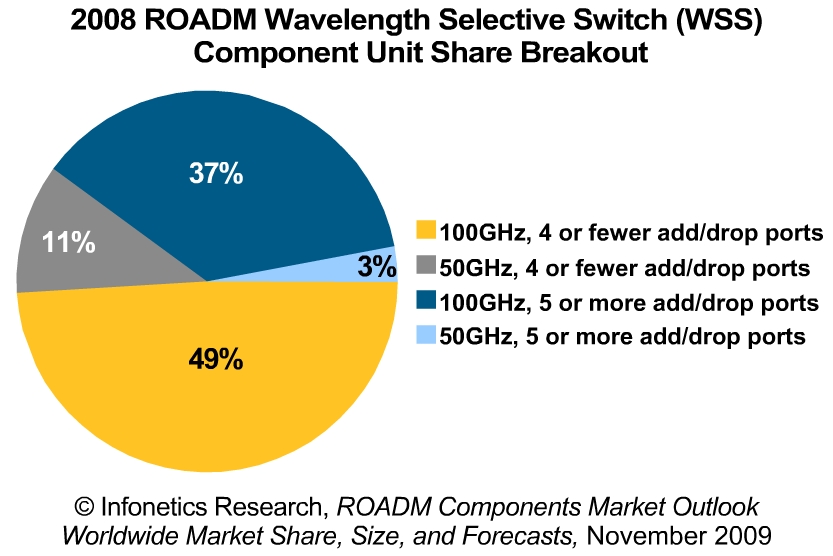ROADMs: Set for double-digit growth
 Tuesday, December 8, 2009 at 5:22PM
Tuesday, December 8, 2009 at 5:22PM A Q&A with Andrew Schmitt, directing analyst, optical at Infonetics Research regarding ROADMs and his report's findings.

Summary
The wavelength-division multiplexing (WDM) reconfigurable optical add-drop multiplexer (ROADM) equipment market will be the fastest growing optical segment over the next few years, according to Infonetics Research. The market research firm in its ROADM Components Market Outlook report predicts that the segment will grow at a compound annual growth rate (CAGR) of 13% from 2008 to 2013.
Q&A
Q. Can you please help by defining some terms? What is the difference between a wavelength-selective switch (WSS) and a ROADM?
AS: A WSS is a component that can direct individual wavelengths among multiple fibers. They are typically built in asymmetrical configurations, such as a 1x9 or a 9x1 and are used in quantity to build logical larger switches, effectively allowing multiple wavelengths to be switched among several incoming and outgoing fibers.
ROADMs are subsystems composed of these WSS modules but also include EDFA amplifiers, splitters, sometimes arrayed waveguide gratings (AWGs), and control electronics that include power balancing.
Q. A ROADM can also be colourless and directionless. What do these terms mean?
AS: For a ROADM to be colourless, it must be capable of dropping wavelengths of the same colour entering the node from both the West and East directions on individual drop ports. Directionless requires that wavelengths added at that node have non-blocking behavior and be capable of being routed either in the West or East direction. Removing these restrictions typically requires more WSSs to be used in the ROADM in place of AWGs, representing a classic flexibility/ cost tradeoff.
Q. In the report you split the WSS into two categories: those with up to four ports and those greater than four ports. Why?
AS: That’s really the breaking point of the market according to carriers I spoke with. Originally, four ports was a high end number but since then larger WSS modules have become available. The market has divided into small, which is 1x2 to 1x4 ports, and large, which at this point are 1x9’s.
 "It is probably the only thing the circuit-loving Bell-heads and the counter-culture IP-bigots can agree on – everybody loves ROADMs."
"It is probably the only thing the circuit-loving Bell-heads and the counter-culture IP-bigots can agree on – everybody loves ROADMs."
Andrew Schmitt
Q. You say that ROADMs will be the faster growing optical equipment segment. What is motivating operators to deploy?
AS: ROADMs save money, plain and simple. When you use a ROADM, you eliminate the need to do an electrical-optical conversion and the electronics required to support it. It is particularly attractive for IP over WDM configurations, where expensive layer three router ports can be bypassed. Electrical-optical conversion is where the cost is in networks and ROADMs allow any given node to only touch the traffic required at that node. It’s probably the only thing the circuit-loving bell-heads and the counter-culture IP-bigots can agree on – everybody loves ROADMs.
Q. Are there regional differences in how ROADMs are being embraced? If so, why?
AS: North America, Japan and Europe have seen the bulk of deployments. But that has started to change with smaller carriers in developing countries adopting ROADM, particularly in Asia Pacific.
Q. Did you learn anything that surprised you as part of this research?
I assembled historical estimates of the WSS market back to 2005 through conversations with WSS vendors and equipment makers. Most people were very co-operative. When I was writing the final report, I overlayed historical WSS component revenue with the Infonetics’ ROADM optical equipment revenue we have tracked over the past years, and there was an extremely tight correlation. Where there wasn’t a correlation there was a logical reason behind it – adding more ROADM degrees to existing nodes.
Covering the component market and the equipment market makes the research much better than if I did each market individually. I’ve done a lot of research in the past few years in both technical and financial domains but this was the second most interesting – it was really refreshing to find a big double-digit growth market in optical.
Cisco System’s CEO, John Chambers, has been very public in his goal to grow the company at 15% annually, and I don’t think it is an accident that the Cisco optical group makes ROADM solutions a number one priority. They’ve silently moved up to second in market share for North American WDM, and their ROADM expertise played a big role in this.
The wavelength-division multiplexing (WDM) reconfigurable optical add-drop multiplexer (ROADM) equipment market will be the fastest growing optical segment over the next few years, according to Infonetics Research.
The market research firm in its ROADM Components Market Outlook report predicts that the segment will grow at a compound annual growth rate (CAGR) of 13% from 2008 to 2013.
Andrew Schmitt, directing analyst, optical at Infonetics discusses some of the issues regarding ROADMs and his report findings.




Reader Comments